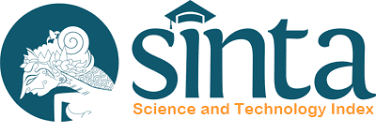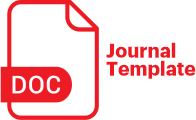Optimasi Metode CART Menggunakan Metode Bagging Pada Studi Kasus Data Imbalance Berbasis Metode Adasyn
DOI:
https://doi.org/10.26555/jim.v10i1.30874Keywords:
Data Imbalance,, CART,, ADASYN,, BAGGING,Abstract
Penelitian ini membahas mengenai permasalahan data imbalance yang menyebabkan kinerja dari model klasifikasi menjadi tidak optimal. Dalam penelitian ini menerapkan metode Adaptive Synthetic Sampling (ADASYN) untuk menangani permasalahan data imbalance, metode Classification and Regression Tree (CART) diterapkan sebagai metode klasifikasi pada dataset penyakit stroke, dan metode Boostrap Agregating (Bagging) untuk mengoptimalkan metode Cart. Penelitian ini bertujuan untuk mengetahui cara kerja dan performa dari penerapan metode Adasyn, Cart, dan Bagging dengan membangun tiga model klasifikasi yaitu model Cart, model Cart Adasyn, dan model Cart Adasyn Bagging. Hasil penelitian menunjukan model Cart menghasilkan nilai akurasi sebesar 94%, G-mean sebesar 0%, dan AUC sebesar 50%. Model Cart Adasyn menghasilkan nilai akurasi 78%, G-Mean 74% dan AUC 74%. Model Cart Adasyn Bagging menghasilkan nilai akurasi 78%, G-mean 76%, dan AUC 76%. Oleh karena itu, dapat disimpulkan bahwa kombinasi metode Cart, Adasyn, dan Bagging memberikan performa terbaik dalam mengatasi data tidak seimbang untuk klasifikasi penyakit stroke. Model Cart Adasyn Bagging terbukti lebih baik dalam memprediksi kedua kelas mayoritas dan kelas minoritas.
References
B. Krawczyk, “Learning from imbalanced data: open challenges and future directions,” Prog. Artif. Intell., vol. 5, no. 4, pp. 221–H. He, Y. Bai, E. A. Garcia, and S. Li, “ADASYN: Adaptive synthetic sampling approach for imbalanced learning,” Proceedings of the International Joint Conference on Neural Networks, 2008, pp. 1322–1328. doi: 10.1109/IJCNN.2008.4633969.
N. G. Ramadhan, “Comparative Analysis of ADASYN-SVM and SMOTE-SVM Methods on the Detection of Type 2 Diabetes Mellitus,” Sci. J. Informatics, vol. 8, no. 2, pp. 276–282, 2021, doi: 10.15294/sji.v8i2.32484.
S. N. Lathifah, F. Nhita, A. Aditsania, and D. Saepudin, “Rainfall forecasting using the classification and regression tree (CART) algorithm and adaptive synthetic sampling (study case: Bandung regency).,” in 2019 7th International Conference on Information and Communication Technology (ICoICT), 2019, pp. 1–5. doi: 10.1109/ICoICT.2019.8835308.
S. Gocheva-Ilieva, H. Kulina, and A. Ivanov, “Assessment of students’ achievements and competencies in mathematics using cart and cart ensembles and bagging with combined model improvement by mars,” Mathematics, vol. 9, no. 1, pp. 1–17, 2021, doi: 10.3390/math9010062.
R. Kustiawan, A. Adiwijaya, and M. D. Purbolaksono, “A Multi-label Classification on Topic of Hadith Verses in Indonesian Translation using CART and Bagging,” J. Media Inform. Budidarma, vol. 6, no. 2, p. 868, 2022, doi: 10.30865/mib.v6i2.3787.
H. Kulina and S. Gocheva-Ilieva, “CART Ensemble and Bagging Algorithm for Estimating of FactorsInfluencing the Furniture Market - Pending to add,” no. August, 2023.
W. Imtiyaz, N. Satyahadewi, and H. Perdana, “Application of Bagging Cart in the Classification of on-Time Graduation of Students in the Statistics Study Program of Tanjungpura University,” BAREKENG J. Ilmu Mat. dan Terap., vol. 17, no. 4, pp. 2243–2252, 2023, doi: 10.30598/barekengvol17iss4pp2243-2252.
Downloads
Published
Issue
Section
License
Copyright (c) 2025 Khana Pujiyanti

This work is licensed under a Creative Commons Attribution-NonCommercial-ShareAlike 4.0 International License.
Authors who publish with this journal agree to the following terms:
1. Authors retain copyright and grant the journal right of first publication with the work simultaneously licensed under a Creative Commons Attribution License that allows others to share the work with an acknowledgment of the work's authorship and initial publication in this journal.
2. Authors are able to enter into separate, additional contractual arrangements for the non-exclusive distribution of the journal's published version of the work (e.g., post it to an institutional repository or publish it in a book), with an acknowledgment of its initial publication in this journal.
3. Authors are permitted and encouraged to post their work online (e.g., in institutional repositories or on their website) prior to and during the submission process, as it can lead to productive exchanges, as well as earlier and greater citation of published work.

This work is licensed under a Creative Commons Attribution-ShareAlike 2.0 Generic License.









